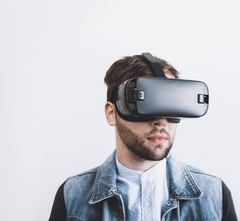Global Scans · Virtual Reality · Weekly Summary

- [New] Metaverse VR 2025 is the ultimate frontier in immersive technology, and the range of opportunities within it is huge, starting with digital assets and tokenized real estate up to gaming economies, VR/AR integration, and Web3 social platforms. metavaultchain
- [New] With the rise of domestic travel and a new generation of tech-savvy millennials, VR tourism in India is expected to see rapid growth in the coming years. Travel And Tour World
- [New] XR technologies, including AR, VR, and MR, will have transitioned from experimental tools to essential core applications by 2025. openpr
- AR/VR headset shipments will exceed 100 million units by 2025, signaling significant shifts in both consumer and enterprise markets. openpr
- Over the next three to five years, VR will reemerge transformed by the convergence of Generative AI, Physical AI and spatial computing. Forbes
- IDC projects AR/VR headset shipments will grow 39.2% in 2025; affordability is a driver. Glass Almanac
- The overall valuation of the virtual reality sector dedicated to medical simulation has seen substantial, rapid expansion lately, projected to climb from a sum of $4.7 billion in the year 2024 to an estimated $6.28 billion by 2025, reflecting a robust compound annual growth rate of 33.7%. openpr
- Spending on AR/VR in education will grow at 45% CAGR through 2025. Futurist Speaker on AI Leadership, Future of Work, Futu
- Despite billions in investment from Meta, Apple, Sony and Samsung, despite increasingly impressive technical specifications, and despite a decade of promises that in 2025 will be different - VR headsets remain expensive, uncomfortable curiosities gathering dust on shelves. The Sydney Morning Herald
- MarketBeat's screener flags Meta Platforms, zSpace, and The Glimpse Group as today's Virtual Reality stocks to watch based on the highest recent dollar trading volume, noting VR names provide exposure to immersive tech but carry higher volatility and R&D/adoption risk. MarketBeat
- By 2025, 5G will enable businesses to leverage advanced technologies such as IoT devices, augmented reality, and virtual reality in ways previously unimaginable. SMS-iT Blog
- Virtual reality is becoming a staple in training centers and is projected to reach more than $5 billion by 2027. Advanced Manufacturing
- Global 5G connections are forecast to surpass 1 billion in 2025, driving a rapid increase in streaming, cloud gaming, and AR/VR adoption on mobile. demandsage
- Virtual reality technology continues to evolve, and fall 2025 will introduce next-generation headsets designed to deliver immersive gaming experiences. Medium
- Meta Platforms, zSpace, DIH Holding US, and The Glimpse Group are among the top Virtual Reality stocks to watch, indicating strong interest in the VR sector due to potential growth opportunities. MarketBeat
- Apple expects to ship more than 10 million AR/VR products in 2027, including a Ray-Ban Meta-style smart glasses product projected for 3 million to 5 million shipments. Next Reality
- By 2025, 45% of insurance companies will have introduced VR into customer service workflows, reducing in-person support needs and cutting customer service costs by 30%. CoinLaw
- Remote Monitoring and Content Delivery combined contribute 25% share (USD 4.1 billion), while AR/VR is the fastest-growing sub-segment, projected to exceed USD 9 billion by 2032 due to immersive applications. Cision PR Newswire
- More than 71% of medical organizations used AR/VR in 2021, with the healthcare XR industry expected to reach more than $14 billion by 2028. Advanced Manufacturing
- The two-year Resilience programme, set up with £4.5 million ($6 million) in government funding last year, uses new tools such as virtual reality and mixed reality to train medicine makers in skills which would be impractical, disruptive, and expensive to gain in the real world. Pharmaphorum
- Apple Inc. (AAPL) and Meta Platforms, Inc. will leverage 6G for immersive AR/VR experiences. FinancialContent
- Though gaming remains a central pillar, VR is finally diversifying into a multi-purpose platform that will solve many human challenges by 2025. Medium
- India alone is expected to generate US$ 917.5 million in AR/VR revenues in 2025, with penetration climbing past 50% by 2029. APN News
Last updated: 15 December 2025
